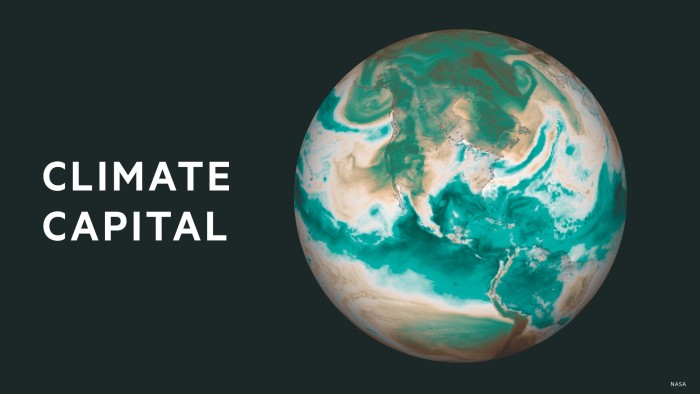Stay informed with free updates
Simply sign up to the Visual and data journalism myFT Digest — delivered directly to your inbox.
This article is an on-site version of our Climate Graphic: Explained newsletter. Sign up here to receive it in your inbox each Sunday.
The world’s ocean temperatures remained at elevated levels in May according to the latest monthly bulletin from Copernicus, the European Earth observation agency.
Global sea surface temperatures were the second highest since records began at 20.79C, just 0.14C cooler than last year’s record. The naturally occurring La Niña cycle in the Pacific, which typically has a cooling effect, lasted only a few short months and failed to help reduce the temperature.
This long-term warming trend is causing concern among scientists — as the ocean warms its ability to absorb carbon dioxide and heat from the atmosphere diminishes “potentially accelerating the build-up of greenhouse gases in the atmosphere and intensifying future climate warming,” Copernicus senior scientist Julien Nicolas said.
This worrying prognosis follows an alert by the US National Oceanic and Atmospheric Administration (Noaa) in recent days that atmospheric concentrations of carbon dioxide had hit their highest seasonal peak since records began.
The level of CO₂ in the atmosphere peaked globally at the mean of 426 parts per million in March, up from 423 ppm a year ago, and surpassed 430 ppm at the Mauna Loa Observatory in Hawaii. The greenhouse gas concentration has risen from about 300 ppm over the past 60 years.
Despite average sea surface temperatures last month overall registering slightly below the May 2023 peak, some regions are still experiencing records heat.
In the north Atlantic, off the coast of the UK and Ireland, a marine heatwave developed in May that surpassed the previous peak, with temperatures reaching 4C above the 1991-2020 long-term average. Iceland and Greenland offshore temperature were also raised, and most of the Mediterranean was also much warmer than average for May, said Copernicus.
How we made it
To illustrate the marine heatwave in the north Atlantic I decided it was best to employ two approaches. The first being one our favourite chart types for climate data, the ‘spaghetti chart’, which allows the reader to compare latest data with annual data going back to when records began in 1979.
Historical data is important in providing context and showing just how much of an outlier the readings for the month of May were — almost one full Celsius degree warmer than the previous highs for the month on some days.

For the second graphic, I created a temperature anomaly map to show exactly where the heatwave was taking place.
The chart and map referred to a very specific part of the north Atlantic Ocean so I wanted to make sure this was clearly marked. The area is defined as 25ºW to 0ºE and 44ºN to 66ºN, but how do I get this area on to my map?
First, the anomaly data was loaded into Qgis, our preferred geographic information system software, and styled using a diverging colour ramp, as this is the most intuitive when handling anomaly data.
Sea surface temperature changes in the region can be subtle, so employing a standard temperature scale with a single colour ramp would have made it difficult to identify the variation. But by using a red-blue diverging colour scale, with white being the long-term average, the shift from cool (blue) to warmer (red) waters is emphasised.

[Nerd note: There are several ways to draw a specific area on a map in Qgis, but the easiest method is to create a CSV with just two cells of data. The first cell is just a column name, in the example below I called it geom (short for geometry).
In the second cell are the four corner coordinates of the defined area — they need to be entered in order, either clockwise or anticlockwise. This file is then loaded into Qgis, which interprets the file as a WKT (well known text) format and translates the coordinates into a polygon.]
A study published in Nature this month said the extreme warming that began in the north Atlantic during the summer of 2023 was driven by the exchange of heat between the ocean and the atmosphere, rather than heat transfer within the ocean. The researchers said such heatwaves were likely to worsen.
Matthew England, one of the study authors and Scientia professor at the University of New South Wales, commented that the elevated sea temperatures around UK and Ireland demonstrated “global warming playing out before our eyes”.
Climate Capital

Where climate change meets business, markets and politics. Explore the FT’s coverage here.
Are you curious about the FT’s environmental sustainability commitments? Find out more about our science-based targets here
